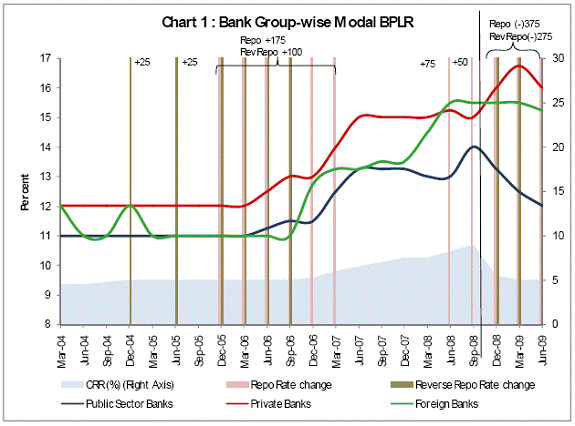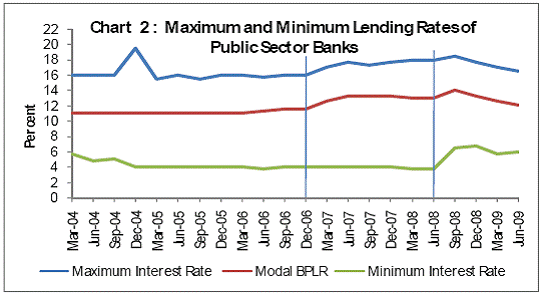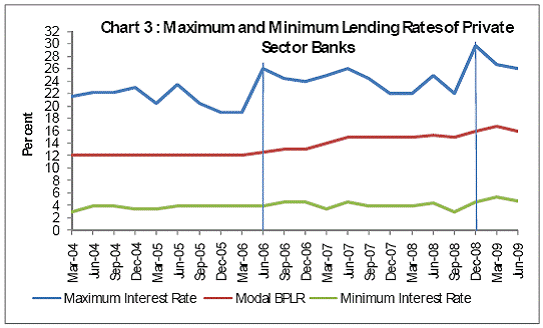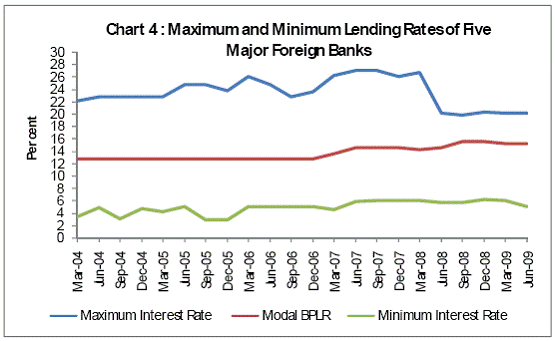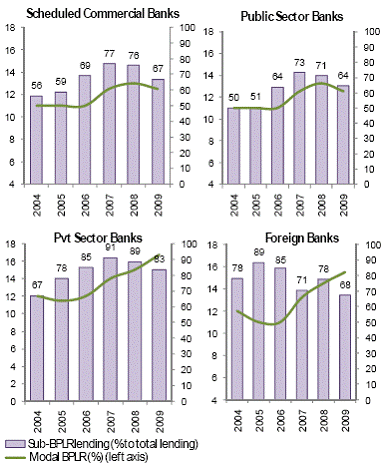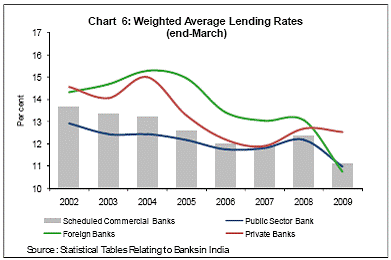 IST,
IST,
Evolution of BPLR in India
2.1 Consistent with the objective of providing credit to the productive sectors of the economy, the lending rates as well as the allocation of bank credit, was, by and large, regulated by the Reserve Bank till the late 1980s. Further, there were numerous sector-specific, programme-specific and purpose-specific credit stipulations provided from time to time. Initial attempt to rationalise the administered lending rate structure was made in September 1990 by removing multiplicity and complexity of interest rates. Interest rates on advances, other than advances under Differential Rate of Interest Scheme1 and export credit, were linked to the size of advances. Under this revised structure of lending rates, the advances of scheduled commercial banks were divided into six slabs and progressively higher interest rates were prescribed for larger advances (subject to a floor rate). While for the lowest slab consisting of advances amounting up to Rs. 7,500, a minimum interest rate of 10 per cent per annum was prescribed, advances of above Rs. 2 lakh, which fell under the highest slab were prescribed a minimum rate of interest of 16 per cent per annum. The above rationalised structure of lending rates was applied to both working capital and term loans. However, concessional rates were offered on term loans to agriculture, small-scale industry and specific transport operators. Deregulation of Lending Rates and the Emergence of Prime Lending Rates (PLR) 2.2 After the initiation of financial sector reforms in the early 1990s, various steps were initiated to deregulate the lending rates of commercial banks. The credit limit size classes of scheduled commercial banks, on which administered rates were prescribed, were reduced into three slabs in April 1993. The slabs or credit limit size class under the revised guidelines consisted of three categories: (i) advances up to and inclusive of Rs. 25,000; (ii) advances over Rs. 25,000 and up to Rs. 2 lakh; and (iii) advances over Rs. 2 lakh. In a major step towards deregulation of lending rates, it was decided in October 1994 that banks would determine their own lending rates for credit limits over Rs.2 lakh in accordance with their risk-reward perception and commercial judgment. Banks were at the same time required to declare their prime lending rate (PLR), the rate charged for the prime borrowers of the bank, with the approval of their boards taking into account their cost of funds, transaction cost, etc. Initially, the PLR acted as a floor rate for credit above Rs. 2 lakh. Subsequently, onaccount of the large instances of banks charging lending rates far higher than PLR on a significant portion of bank credit to borrowers with credit limit to over Rs. 2 lakh, in October 1996 it was made mandatory for banks, while announcing the PLR, to also announce the maximum spread over the PLR for all advances other than consumer credit. 2.3 In order to bring about greater discipline in the utilisation of bank credit and gain better control over credit flow, a ‘loan system’ of delivery of bank credit was introduced in April 1995, whereby the banks were given the freedom to charge interest rate on the ‘cash credit’ and ‘loan’ components with reference to the prime lending rate approved by their Boards. Further, in February 1997, in order to encourage borrowers to switch to loan delivery system, banks were allowed to prescribe separate PLRs and spreads (over PLRs) for both loan and cash credit components. 2.4 In October 1997, with regard to term loans of 3 years and above, the banks were given the freedom to announce separate Prime Term Lending Rates (PTLR), while PLR remained applicable to the loans taken for working capital and short-term purposes. With a view to removing the disincentive to the flow of credit to small borrowers below Rs.2 lakh, instead of prescribing a specific rate uniformly for all banks, PLR was converted as a ceiling rate on loans up to Rs. 2 lakh in April 1998. The rationale for this policy was that the PLR, being the rate chargeable to the best borrower of the bank, should be the maximum rate chargeable to the small borrowers. Tenor- linked Prime Lending Rates (TPLRs) 2.5 The system of PLRs and spread above PLR that were being implemented had by and large served the purpose of ensuring transparency and objectivity. In addition to the two PLRs that banks were permitted to operate – one for short term and the other for long term loans - there were request from banks and borrowers for tenor linked PLR, i.e., PLR for different maturities. Hence, the concept of tenor-linked prime lending rates (TPLRs) was introduced in April 1999 to provide banks with freedom to operate different PLRs for different maturities, provided the transparency and uniformity of treatment that were envisaged under the PLR system continued to be maintained. Moreover in October 1999, with the aim of imparting greater operational flexibility to banks in the applicability of PLR, based on suggestions received from banks and other market participants, banks were given the freedom to charge interest rates without reference to the PLR in respect of certain categories of loans/credit such as loans covered by refinancing schemes of term lending institutions, lending to intermediary agencies, discounting of bills and advances/overdraft against domestic/ NRE/FCNR(B) deposits. As announced in the Annual Policy Statement for 2000-01, banks were permitted to charge fixed/floating rates on all loans with credit limit of more than Rs. 2 lakh with PLR as the reference rate. Banks were, however, advised to ensure that while sanctioning such loans, the PLR stipulations as applicable were complied with and the nature of alignment with PLR in the case of both fixed and floating rate loans/advances made explicit at the time of sanction of the loan. Relaxation of PLR and sub-PLR lending 2.6 The Monetary and Credit Policy for the year 2001-02 noted that “…in recent meetings with bankers, a request was made that the PLR should be converted into a reference or benchmark rate for banks rather than treating it as the minimum rate chargeable to the borrowers. In this context, a review of the international practices also shows that while the PLR was traditionally the lowest rate charged to the prime borrowers with highest credit rating, in recent years, the practice of providing loans even below the PLR by banks has become common…” (para 82 of Monetary and Credit Policy for the year 2001-2002, April 19, 2001). 2.7 Accordingly, keeping in view the international practice and to provide further operational flexibility to commercial banks in deciding their lending rates, the Reserve Bank relaxed the requirement of PLR being the floor rate for loans above Rs.2 lakh in its Annual Policy Statement for the year 2001-02. Banks were allowed to offer loans at below-PLR rates to exporters or other creditworthy borrowers including public enterprises on the lines of a transparent and objective policy approved by their respective boards. Thus beginning April 19, 2001 commercial banks were allowed to lend at sub-PLR rates for loans above Rs.2 lakh. However, even while doing so, banks were required to continue with the earlier practice of declaring the maximum spread of interest rates charged on loans which were priced above the PLR. Given the prevailing structure of the credit market in India and the need to continue with concessionality for small borrowers, the practice of treating PLR as the ceiling for loans up to Rs.2 lakh was continued forthwith. 2.8 Large capital inflows and a number of monetary easing measures undertaken by the Reserve Bank, as part of its overall monetary policy stance to promote growth, resulted in abundant liquidity during 2001-04. As a result, interest rates in general softened considerably in this period. However, reduction in interest rates in general was not uniformly reflected in the lending rates across all banks. It was also observed that the actual lending rates by banks were much higher than their PLRs on a significant portion of bank credit to borrowers with credit limits of over Rs.2 lakh. Therefore, in the Monetary and Credit Policy for the year 2002-03, banks were urged to review the present maximum spreads over PLR and reduce them wherever they were unreasonably high so that credit was available to the borrowers at reasonable interest rates. Banks were also advised to announce the maximum spread over PLR to the public along with the announcement of their PLRs. 2.9 With a view to enhancing transparency with regard to actual interest rates for depositors as well as borrowers, in the interest of customer protection as also meaningful competition, the reporting requirements to the Reserve Bank by commercial banks on loan pricing were augmented. The Reserve Bank, beginning June 2002, started monitoring the actual trend in lending rates in India through information received from banks at regular intervals. Additional information was sought from banks on the maximum and minimum rates charged by them. Banks were advised to submit information on the maximum and minimum interest rates after taking out extreme values in the interest rates (say, up to 5 per cent of advances on either side). Further, banks were also advised to furnish the range of interest rates in which large value of business (say, 60 per cent or more of advances) was contracted in order to monitor the general trend in lending rate charged by banks in India. The quarterly information on lending rates so collected under the special quarterly return VI-AC was placed on the Reserve Bank’s website. It is now available for the period beginning June 2002. Banks were also urged to switch over to 'all in cost' concept for borrowers by explicitly declaring the processing charges, service charges, etc. charged to borrowers and to place the information on such bank charges in the public domain. Benchmark Prime Lending Rate 2.10 The Mid-Term Review of Monetary and Credit Policy for the year 2002-2003 observed that based on the information collected under the new reporting standards introduced, both PLR and spread were seen to vary widely across banks/bank-groups. The Mid-Term Review noted that in a competitive market, PLRs among various banks/bank-groups should converge to reflect credit market conditions and that the spreads around the PLR should be reasonable. It called on the banks to review both their PLRs and spreads and to align spreads within reasonable limits around PLRs, subject to approval of their boards. However, the divergence in PLR and the widening of spreads between bank borrowers continued to persist. Moreover, the prime lending rates continued to be rigid and inflexible in relation to the overall direction of interest rates in the economy. 2.11 With an aim of introducing transparency and ensuring appropriate pricing of loans – wherein the PLRs truly reflect the actual costs – in the Annual Policy Statement of April 2003, the Reserve Bank advised banks to announce a Benchmark PLR (BPLR) with the approval of their boards. The BPLR was seen as a reference rate and was to be computed taking into consideration (i) cost of funds; (ii) operational expenses; and (ii) a minimum margin to cover regulatory requirements of provisioning and capital charge, and profit margin. At the same time, given the lack of transparency, banks were also advised to discontinue the system of tenor-linked PLR since all other lending rates could be determined with reference to the single Benchmark PLR arrived at by taking into account term premia and/or risk premia. Banks were also permitted the flexibility in pricing floating rate loans and advances using market benchmarks and time varying spread in an objective and transparent manner. Further, interest rates on a number of loans and advances such as advances for acquiring residential properties and purchase of consumer durables could be determined without reference to the benchmark PLR. Almost all banks implemented the system by April 2004 after the IBA specified the detailed guidelines. 2.12 The Reserve Bank refrained from issuing detailed/micro level regulatory guidelines on the manner in which the components of BPLR were to be computed. Banks however sought the Reserve Bank’s advice on standardised methodology for the computation of BPLR for all banks. Banks however highlighted the need to have differential pricing strategies owing to different risks of defaults in different segments which needed different load factors for capital charges. Generally, as banks offered various products which differed in terms of ‘capital committed’ and ‘resources allocated’, banks felt that there was need for flexibility in loan pricing to reflect in the interest rate characteristics of the product, including credit and market risks and the structuring required. Banks also mentioned the fact that since transaction costs were different for different sectors such as consumer and corporate business accounts, there was a need to have different pricing structures for these segments. To accommodate the above concerns, banks wanted the Reserve Bank to allow separate BPLRs for pricing loans in different sectors. Besides, as changes in interest rates over a period of time made it difficult to consider term premia as a fixed component in the pricing of loans, need was also felt by banks for resetting term premia, particularly for loans with longer term maturities. Banks also suggested that short-term lending rates could not be linked to historical accounting data, they may prefer to deploy their surplus funds to highly rated borrowers even if a slightly higher spread was available over the yield of money market instruments. While taking cognisance of banks’ observations, it was deemed appropriate by the Reserve Bank to announce the introduction of the BPLR system in the interest of transparency in the pricing of credit. 2.13 In order to monitor the BPLRs of banks, the Reserve Bank introduced a system of collecting information from banks and publicly disseminating it in various publications. The Weekly Statistical Supplement (WSS) of the Reserve Bank of India Monthly Bulletin disseminates information on the BPLRs of five major public sector banks. The information on BPLRs and actual lending rates of SCBs is also regularly disseminated on a quarterly basis through the Reserve Bank’s website (/en/web/rbi). 2.14 Subsequently, reviewing the BPLR system, the Mid-Term Review of the Annual Policy Statement for the year 2005-06 observed that the system of BPLR had evolved in a manner that had not fully met expectations. Competition had forced the pricing of a significant proportion of loans far out of alignment with BPLRs and in a non-transparent manner. As a consequence, this had undermined the role of the BPLR as a reference rate. Furthermore, there was a public perception that there was under-pricing of credit for corporates while there could be overpricing of lending to agriculture and small and medium enterprises. Several requests were received by the Reserve Bank from banks suggesting a review of the BPLR system. Therefore, a need has arisen to review the current procedures and processes of pricing of credit through a well structured and segment-wise analysis of costs at various stages of intermediation in the whole credit cycle. The evolution of the BPLR system in India is summed up in Table 1.
Trends in BPLRs 2.15 The lending rates of different banks in a deregulated competitive environment by nature are expected to be different as the cost of funds, cost of operations and margins for capital charge and profits for each bank are different. However, the experience of the BPLR system shows that BPLR of different bank groups have tended to vary significantly. Bank-Group wise Trends in BPLR 2.16 The bank group-wise trends in the modal BPLR since March 2004 show three distinct phases. In the first phase between March 2004 and March 2006, the BPLRs of public sector banks and private sector banks remained almost steady and range bound, though the BPLRs of private sector banks were about 100 bps higher than those of public sector banks. BPLRs of foreign banks showed some variations, but converged to BPLR of public sector banks by March 2006. During March 2006 to June 2007, modal BPLRs of all three bank groups showed sharp upward movement in line with the general tightening of monetary conditions. Even in this phase, modal BPLRs of private sector banks remained at around 100 bps higher than those of public sector bank. Modal BPLRs of foreign banks remained close to those of public sector banks. In the next phase from June 2007 to September 2008, the divergence in the modal BPLRs of public sector banks and private sector banks widened somewhat; modal BPLRs of foreign banks converged to the modal BPLR of private sector banks. However, since September 2008, modal BPLRs of private and public sector banks have diverged significantly. The modal BPLRs of public sector banks have shown a significant decline since September 2008, while those of private banks' after showing an upward movement till March 2009, have exhibited a downward movement (Chart 1). Responsiveness of BPLR to changes in the Reserve Bank’s Policy Rates 2.17 An empirical exercise carried out to ascertain the responsiveness of modal BPLR to the changes in the Reserve Bank’s policy rates (repo rate) for the period from Q1:2004 to Q1:2009 suggests a mixed picture across the bank groups and interest rate cycles (Table 2 and Annex 2). An increase in the repo rate was observed to bring about a contemporaneous change in modal BPRLs of private sector banks and major foreign banks and a lagged response in the case of public sector banks. A decrease in the repo rate had a significant contemporaneous impact only in the case of public sector banks. This asymmetric response shows that while public sector banks were slow to respond to an increase in policy rate, they were quick on the reverse. This could be attributed to the ownership structure of public sector banks which makes them more amenable to moral suasion by the authorities. Apart from the policy rate, the weighted average call money rate was also used to assess the impact on modal BPLRs. An increase in the weighted average call money rate, an indication of tightness of liquidity, was observed to have a significant contemporaneous effect across all bank groups. A decline was seen to have a significant impact, albeit with a lag in the case of public sector banks and contemporaneous as well as lagged impact in the case of private banks while in the case of five major foreign banks, no significant impact was seen.
2.18 An analysis of the interest rate spreads around modal BPLR for the period March 2004 to 2009 revealed considerable variations among different bank groups. Minimum interest rates, in particular, showed relatively subdued movements suggesting that they were rather insensitive to the overall movements in BPLRs. 2.19 The maximum and minimum spread of lending rates around BPLR of public sector banks has remained broadly stable since March 2004, barring a brief period between March 2007 over June 2008, when the spread around BPLR, especially the minimum spread below BPLR, increased significantly (Chart 2). 2.20 In the case of private sector banks, maximum interest rate exhibited considerable variations during the March 2004 - June 2009 period. The spread particularly widened in December 2008, before narrowing down in June 2009 (Chart 3). 2.21 In the case of five major foreign banks, both the minimum and maximum lending rates have shown wide variations. The maximum lending rate which stood at a peak of 27.0 per cent in March 2008, declined to 19.8 per cent in September 2008, before increasing moderately to 20.0 per cent in June 2009 (Chart 4). 2.22 The movements in BPLR, however, do not capture a true picture of lending interest rates in the country as banks resort to sub-BPLR lending to a varying degree. It is observed that in the case of all scheduled commercial banks, except foreign banks, periods of increase in share of sub-BPLR lending were also associated with high BPLR rates (Chart 5). Chart 5: Modal BPLR and Sub-BPLR lending by SCBs 2.23 An empirical analysis of the relationship between changes in BPLRs and sub-BPLR lending rates for select major banks showed that they were positively related2. As established by the empirical results above, the co-movements in BPLR and sub-BPLR lending could be for the reason that banks are unable to reduce their BPLRs, which are worked out based on the average cost of funds, when the marginal costs declines. This resulted in incremental lending at sub-BPLR. True movements in lending interest rate of banks, therefore, are better captured in the weighted average lending rate of banks. Though there was considerable divergence in weighted average lending rates in 2004 among the various bank groups, the weighted average lending rates have tended to converge in the recent period. Furthermore, the weighted average lending rate kept coming down beginning 2002 before rising in 2008. However, the weighted average lending rate was lower in 2008 than in 2005. In 2009, the weighted average lending rates have registered a significant decline, except in the case of private banks (Chart 6). Major Issues in the BPLR-based System 2.24 The BPLR system was expected to be a step forward from the PLR system, which more or less represented the minimum lending rates, to that of one which stood as a benchmark or a reference rate around which most of the banks’ lending was expected to take place. However, over a period of time, several concerns have been raised about the way the BPLR system has evolved. Extent of Sub-BPLR Lending 2.25 Following the permission given for sub-BPLR lending, banks were permitted to offer sub-BPLR rates to exporters and other creditworthy borrowers, including public sector enterprises on the lines of a transparent objective policy approved by their respective boards. Sub-BPLR lending was expected to be at the margin. However, over the years, because of competitive pressures banks have increasingly resorted to financing of various categories of borrowers at sub-BPLR rates such as corporates, housing and retail sector. An examination of the data on sub-BPLR lending reveals that the share of sub-BPLR lending (excluding export credit and small loans) for scheduled commercial banks which was at 28 per cent in March 2002, increased to 77 per cent in September 2008, before declining to 67 per cent in March 2009 (Table 3 and Annex 3). In the case of public sector banks (PSBs), the share of sub-BPLR lending was 73 per cent in March 2007, declined marginally to 64 per cent by March 2009 (Annex 4). The sub-BPLR lending of private sector banks moderated from the elevated level of 91 per cent in March 2007 to 84 per cent in March 2009 (Annex 5). Similarly, the sub-BPLR lending of foreign banks, which touched a high of 81 per cent in June 2008, declined to 68 per cent in March 2009 (Annex 6). 2.26 At the disaggregated level, the major share of sub-BPLR lending was of longer term loans (above 3 years), whereas in respect of private sector banks and foreign banks, the major share of sub-BPLR loans was in the form of consumer credit. The Group deliberated on the possible reasons for such a sharp increase in sub-BPLR loans. The Group recognised that in the event of temporary excessive liquidity, there could be a case for short-term lending at rates lower than BPLR. However, the large share of such sub-BPLR loans of higher tenor would suggest that in the absence of the practice of sub-BPLR lending, BPLRs of banks would have been significantly lower than their current levels.
Lack of Transparency 2.27 Transparency in bank lending is understood as bank lending practices with appropriate information disclosures that ensure that the borrowers clearly understand the terms and conditions. Higher levels of transparency can be achieved by disclosing important information on loan pricing and possible fees to the borrower before he or she signs an agreement. Transparency also implies that banks must not indulge in irresponsible lending by having hidden additional costs and unexpected rate increases the possibility of which is not made known upfront to the borrower. It should be ensured that all charges and possibility of increases are made clear to the borrower at the beginning of the agreement. The existence of a benchmark rate, to which the various loans are tied to, is a crucial component in attaining transparency in loan pricing. 2.28 Given the large proportion of sub-BPLR lending by the banking system, concerns have been raised on the transparency aspect of computation of BPLRs by banks. In terms of definition, the components of the BPLR include the cost of funds of both purchased deposits and funds borrowed from markets, operational expenses including fixed and variable costs incurred by a bank, minimum margin to cover regulatory requirement of provisioning/capital charges and profit margin the appropriateness of which should be determined by the bank itself. 2.29 The Reserve Bank has received several representations on the arbitrariness of resetting the lending rates on loans and the benchmark rates used for pricing floating rate products. Many banks charge lending rates with reference to benchmarks which are internal and non-transparent. In addition, provisions on conditional resetting interest rates are placed as ‘force majeure’ in loan covenants thereby making the terms of contract non-transparent for the borrower. This practice has added further opaqueness in the setting of lending rates since the re-pricing is generally arbitrary and not with reference to a transparent publicly known benchmarks. 2.30 Downward Stickiness of BPLRs 2.31 Another issue that is often raised is the asymmetric downward stickiness of the BPLRs. This not only raises an issue of equity but also results in poor transmission of monetary policy in credit markets. For instance, during the monetary policy tightening phase (March 2004 to September 2008), it has been observed that while banks were often quick in raising lending rates during an upturn in the interest rate cycle, they were slow to bring down the interest rate in the downturn of the interest rate cycle (Table 5).
2.32 One of the major reasons for downward stickiness is the large share of deposits contracted at high rates in the past. The marginal cost of funds is more relevant for banks for pricing current loans/advances rather than the average cost which is computed on the basis of the cost of all outstanding purchased and borrowed liabilities reflected in the balance sheet. The pricing of credit based on marginal cost is, however, impeded by asymmetric contractual relationship with depositors and borrowers. Thus while reduction of interest rates could lead to repayment or swapping of loans taken by borrowers, the fixed nature of deposit contracts imply that banks would continue to pay higher interest rates despite the general decline in interest rates. This produces an impediment to the effective transmission of monetary policy impulses as well. 2.33 Besides, as noted in the Annual Policy Statement 2009-10, the downward stickiness in BPLRs is also attributed to several other factors such as (i) the administered interest rate structure on small savings, which constrains the reduction in deposit rates; (ii) concessional lending rates linked to BPLRs for some sectors, which make overall lending rates less flexible; and (iii) persistence of the large market borrowing programme of the government, which hardens interest rate expectations. As liquidity remains ample, the competitive pressure on lending rates has increased. Cross-subsidisation in Lending 2.34 The BPLR system based on the average costs incurred by banks on fund-based business actually reflects the break-even cost for banks and does not represent “prime lending” rate in the usual sense of the term at which banks accommodate their highly rated/most creditworthy borrowers. However, as in other markets, the scope of differential pricing for different borrowers based on risk-reward perceptions continues on the basis of customer relationship. A large loan offered to a highly rated borrower may be offered at a lower rate below the current all-in-cost BPLR due to little risk and savings on account of processing and monitoring costs. Although justifiable to some extent, such sub-BPLR lending on a large scale has created a perception that large borrowers are being cross subsidised by retail and small borrowers. 2.35 The latest available information as at end-March 2008 (based on the BSR data) suggests that loans to individual borrowers are generally (other than for housing purposes) in the high interest rate range (14 per cent and above).
1 Under the differential rate of interest (DRI) scheme, weaker sections of society are provided small loans at an interest rate of 4 per cent per annum. 2 An OLS regression with partial adjustment was estimated for data on five major public sector banks, four major private sector banks and three major foreign banks for the period 2007 Q1 to 2009 Q1 to explain the changes in BPLRs based on the following explanatory variables (i) change in the share of sub-BPLR lending, (ii) change in the share of personal loans and (iii) liquidity (change in quarterly average of LAF & MSS balances, +increase, - decrease). The results are given below:
|
||||||||||||||||||||||||||||||||||||||||||||||||||||||||||||||||||||||||||||||||||||||||||||||||||||||||||||||||||||||||||||||||||||||||||||||||||||||||||||||||||||||||||||||||||||||||||||||||||||||||||||||||||||||||||||||||||||||||||||||||||||||||||||||||||||||||||||||||||||||||||||||||||||||||||||||||||||||||||||||||||||||||||||||||||||||||||||||||||||||||||||||||||||||||||||||||||||||||||||||||||||||||||||||||||||||||||||||||||||||||||||||||||||||||||||||||||||||||||||||
पेज अंतिम अपडेट तारीख:






